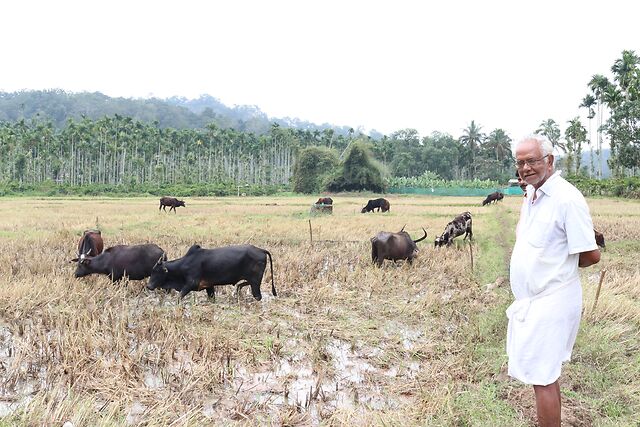Why are the forest-fringe villages of Kerala vulnerable to rabies infection despite mass vaccination campaigns?

Farmer Krishnan Chetty with his livestock at Chettiyalathur, village abutting the forest in Wayanad. (KA Shaji)
With laboratory tests confirming rabies as the reason for the death of a jackal and a dhole in the Thiruvananthapuram and Pathanamthitta districts in recent days, fear has started gripping Kerala’s forest-fringe villages, which often witness crop-raiding and livestock-lifting by wild animals.
It’s unclear whether stray dogs infected with the rabies virus are entering forests and biting the wild animals or the wild animals are getting infected with the virus following exposure to other wild animals that are carriers of the deadly virus.
For several months now, Kerala has been on high alert against the rabies menace: at least 21 people died in January this year after being bitten by rabies-carrying dogs.
As per government figures, 1.96 lakh dog-bite cases were reported across the state since January.
Those who died of rabies included people who were vaccinated against it, and that is the point causing public panic.
After the test results on wild animals conducted by the Kerala State Institute for Animal Diseases (SIAD) at Palode near Thiruvananthapuram became public despite the attempts by the authorities to hide it, forest-fringe villages are now finding another threat to their survival.
“We, the people close to forests, worry a lot. The two confirmed cases are just the tip of the iceberg. Even now, there is no official response to the confirmation. The authorities are hiding a lot,” said PT John, South India coordinator of the Rashtriya Kisan Mahasangh.
The jackal died at the forest-fringe village Kuttiyani in Thiruvananthapuram, while the dhole was found dead at Charalkunnu near Thottapuzhassery in the Pathanamthitta district.
According to forest department sources, the two deaths prompted the creation of “immune buffer zones” in areas close to national parks, wildlife sanctuaries, and reserve forests.
At both Charalkunnu and Kuttiyani, rabid wild animals bit several domestic animals, including dogs and cattle, before dying.
Meanwhile, the confirmation of rabies in the two cases came even as the state government was undertaking an extensive campaign to vaccinate street and pet dogs in the face of increased attacks by them and a surge in the number of cases of rabies deaths.
Local bodies across the state are now conducting mass vaccination programmes.
“The infection among wild animals is a matter of grave concern. As human-animal conflicts are very high in Kerala and stray dogs often interfere with crop-raiding wild animals, urgent measures are needed. Immediate intervention in the case of wild animals is required, along with the ongoing statewide anti-rabies vaccination drive for stray dogs,” said rights activist Prof Kusumam Joseph.
According to public health activist Dr NM Arun, several wild animals are known as carriers of viruses, including the rabies lyssavirus, which causes rabies. In most forest areas of Kerala, regular encounters between wild and domestic animals are happening, and they can reduce the impact of vaccination campaigns in the state.
SIAD’s disease investigation officer and pathologist Dr S Nandakumar also felt that the straying of wild animals into human settlements in districts like Idukki, Wayanad, Palakkad, Pathanamthitta, and Thiruvananthapuram escalated the possibility of rabies-virus transmission to humans.
He believes that rabies infections in Kerala forests must be subjected to extensive studies as it is currently an unaddressed area.
Meanwhile, the Forest Department is probing possibilities of administering oral vaccination to straying wild animals, apart from regular vaccination to domestic animals, in forest-fringe villages.
The department hopes to develop an immune belt that protects livestock and human beings in these areas.
Forest-fringe villages are also vulnerable to other diseases transmitted by wild animals, like nipah, Kyasanur Forest disease (KFD), and scrub typhus.
On its part, the animal husbandry department is now vaccinating all dogs in forest-fringe villages. Booster doses are being administered to those that immunised earlier.
Livestock in vulnerable areas that show symptoms would be isolated and treated. Efforts are also on for the genomic sequencing of the isolated rabies virus and species identification of the wild animals involved.
According to experts, the best preventive effort was to vaccinate all the livestock, at least in a phased manner.
The health threat posed by rabies-infected wild animals came to Kerala’s attention only seven years ago, when Edakkad in Kannur district reported 21 rabid mongooses attacking people.

Apr 26, 2024

Apr 26, 2024

Apr 26, 2024

Apr 26, 2024

Apr 26, 2024

Apr 26, 2024